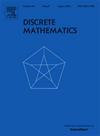Boundedness for proper conflict-free and odd colorings
IF 0.7
3区 数学
Q2 MATHEMATICS
引用次数: 0
Abstract
The proper conflict-free chromatic number, , of a graph G is the least positive integer k such that G has a proper k-coloring in which for each non-isolated vertex there is a color appearing exactly once among its neighbors. The proper odd chromatic number, , of G is the least positive integer k such that G has a proper coloring in which for every non-isolated vertex there is a color appearing an odd number of times among its neighbors. We clearly have . We say that a graph class is -bounded (-bounded) if there is a function f such that () for every . Caro, Petruševski, and Škrekovski (2023) asked for classes that are linearly -bounded (-bounded) and, as a starting point, they showed that every claw-free graph G satisfies , which implies .
In this paper, we improve the bound for claw-free graphs to a nearly tight bound by showing that such a graph G satisfies , and even if it is a quasi-line graph. These results also give further evidence to a conjecture by Caro, Petruševski, and Škrekovski. Moreover, we show that convex-round graphs and permutation graphs are linearly -bounded. For these last two results, we prove a lemma that reduces the problem of deciding if a hereditary class is linearly -bounded to deciding if the bipartite graphs in the class are -bounded by an absolute constant. This lemma complements a theorem of Liu (2024) and motivates us to further study boundedness in bipartite graphs. Among other results, we show that biconvex bipartite graphs are -bounded, while convex bipartite graphs are not even -bounded, and we exhibit a class of bipartite circle graphs that is linearly -bounded but not -bounded.
适当的无冲突和奇数着色的有界性
图G的适当的无冲突色数χpcf(G)是最小的正整数k,使得G具有适当的k着色,其中对于每个非孤立顶点,在其相邻顶点中只出现一次颜色。G的固有奇色数χo(G)是最小的正整数k,使得G具有固有着色,其中对于每个非孤立顶点,在其相邻顶点中都有一种颜色出现奇数次。显然,χ(G)≤χo(G)≤χpcf(G)。如果存在一个函数f,使得对于每一个G∈G, χpcf(G)≤f(χ(G)) (χo(G)≤f(χ(G))),我们说图类G是χpcf有界的(χo-有界)。Caro, Petruševski和Škrekovski(2023)要求线性χ - pcf有界(χ -bounded)的类,并且作为起点,他们表明每个无爪图G满足χpcf(G)≤2Δ(G)+1,这意味着χpcf(G)≤4χ(G)+1。本文通过证明无爪图G满足χpcf(G)≤Δ(G)+6,甚至满足拟线形图的χpcf(G)≤Δ(G)+4,将无爪图的界改进为近紧界。这些结果也为Caro, Petruševski和Škrekovski的猜想提供了进一步的证据。此外,我们还证明了凸圆图和置换图是线性χpcf有界的。对于这最后两个结果,我们证明了一个引理,它将判定一个遗传类是否线性χpcf有界的问题简化为判定该类中的二部图是否被一个绝对常数χpcf有界。这个引理补充了Liu(2024)的一个定理,激励我们进一步研究二部图的有界性。在其他结果中,我们证明了双凸二部图是χpcf有界的,而凸二部图甚至不是χ -有界的,并且我们展示了一类线性χ -有界但不是χpcf有界的二部圆图。
本文章由计算机程序翻译,如有差异,请以英文原文为准。
求助全文
约1分钟内获得全文
求助全文
来源期刊

Discrete Mathematics
数学-数学
CiteScore
1.50
自引率
12.50%
发文量
424
审稿时长
6 months
期刊介绍:
Discrete Mathematics provides a common forum for significant research in many areas of discrete mathematics and combinatorics. Among the fields covered by Discrete Mathematics are graph and hypergraph theory, enumeration, coding theory, block designs, the combinatorics of partially ordered sets, extremal set theory, matroid theory, algebraic combinatorics, discrete geometry, matrices, and discrete probability theory.
Items in the journal include research articles (Contributions or Notes, depending on length) and survey/expository articles (Perspectives). Efforts are made to process the submission of Notes (short articles) quickly. The Perspectives section features expository articles accessible to a broad audience that cast new light or present unifying points of view on well-known or insufficiently-known topics.
 求助内容:
求助内容: 应助结果提醒方式:
应助结果提醒方式:


